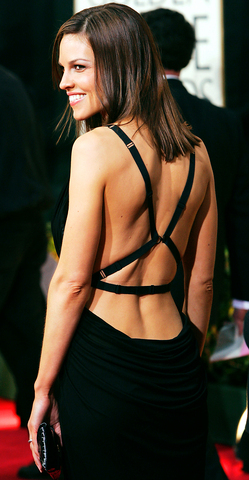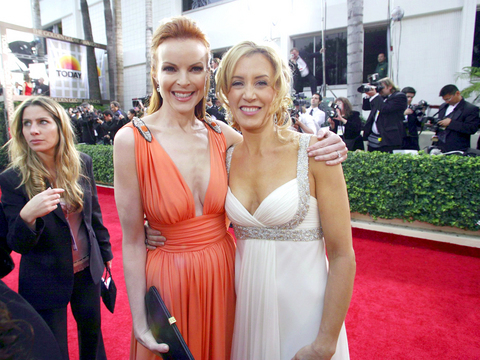The goddesses ruled the Golden Globes, with stars like Felicity Huffman, Maria Bello, Hilary Swank and Marcia Cross wearing plunging V-neck halter gowns with draping, fitted waists and billowing skirts.
Huffman and Bello wore ethereal white, which will be a top spring fashion trend. Bello complemented her white beaded Elie Saab gown with white gardenias in her upswept hair.
Keira Knightley also wore a stunning strapless white dress by Valentino with a rope-style belt, and Sandra Oh wore a white gown with a sophisticated scarf-style back.

PHOTO: AP
``White was the big winner,'' Suze Yalof-Schwartz of Glamour magazine said from the red carpet.
Kate Beckinsale's white dress from the Christian Dior archives was dainty and elegant. She showed a bit of a funky streak with her oversized green earrings.
Reese Witherspoon's short vintage Chanel haute couture was a champagne color with metallic trim.

PHOTO: EPA
Cross' dress, meanwhile, was coral, providing a sharp and stunning contrast to her red hair.
``Marcia looked very goddesslike,'' said Collier Strong, consulting makeup artist for L'Oreal, who helped Cross get ready. ``I knew her makeup had to be lighter and more feminine because the fabric was so billowy. ... It's easy to work with her because she has the most perfect skin you've ever seen.''
Red also had a strong presence on the carpet: Scarlett Johansson wore a red scoop neck Valentino dress with soft ruffles on the straps and down the back; Geena Davis wore a strapless Escada with a jeweled bustier top; and Laura Linney had an asymmetrical version.
`Desperate Housewives star Eva Longoria complemented her red Grecian wrap gown by Bob Mackie with gold platform shoes to boost her petite frame. Longoria told E!'s Isaac Mizrahi that she was sewn into the dress because it wasn't finished until she was walking out the door.
Equally bright was Zhang Ziyi's (章子怡) Giorgio Armani lime green silk tulle gown with a sweetheart neckline and floor-sweeping train.
But some of fashion's favorite faces stuck with classic black -- and proved that it is eternally chic.
Sarah Jessica Parker was in a strapless dress with tiny rows of tulle by Rochas, and Christian Dior's John Galliano designed a custom cocktail dress for Charlize Theron that featured black lace over nude tulle. Swank's black dress by Jean Yu had a sexy back with several straps, and Mary-Louise Parker had a plunging V-front.
Natalie Portman looked Audrey Hepburnesque in a vintage Chanel black lace bustier dress with a ribbon belt and a black-and-white diamond camellia jewel around her waist. Renee Zellweger remained loyal to designer Carolina Herrera, wearing an asymmetrical black silk chiffon dress with rouched detail and a leg-length slit up the left thigh. Zellweger wore a vintage Van Cleef & Arpels brooch pinned to the back of her waist.
Candice Bergen's Michael Kors black turtleneck and ballskirt was a picture of casual elegance. Nicolette Sheridan and Queen Latifah both choose blue dresses. Sheridan's was an Armani sapphire-blue silk chiffon gown with a deep V-neck and pleated bodice, Latifah's a periwinkle goddess number that she accessorized with 23-carat, round-shaped drop diamond earrings with a fancy yellow pear-shaped diamond drop pendant on a diamond chain by Chopard.
Teri Hatcher wore a body-hugging V-neck bronze halter gown with art deco-style beading, loose hair and a small bronze clutch that held her California driver's license. Hatcher told Mizrahi she was told to bring identification to get in at the door. (She also told him that it was her eight-year-old daughter that warned her about her panty lines, so Hatcher showed up to the Globes without underwear.)
``The Globes set the fashion tone for the rest of the season,'' designer Randolph Duke said. ``It's a very chic show. Some [actresses] wear more cocktail dresses. The Globes are an opportunity to do something other than that classic, glamorous Oscar gown.''

April 28 to May 4 During the Japanese colonial era, a city’s “first” high school typically served Japanese students, while Taiwanese attended the “second” high school. Only in Taichung was this reversed. That’s because when Taichung First High School opened its doors on May 1, 1915 to serve Taiwanese students who were previously barred from secondary education, it was the only high school in town. Former principal Hideo Azukisawa threatened to quit when the government in 1922 attempted to transfer the “first” designation to a new local high school for Japanese students, leading to this unusual situation. Prior to the Taichung First

The Ministry of Education last month proposed a nationwide ban on mobile devices in schools, aiming to curb concerns over student phone addiction. Under the revised regulation, which will take effect in August, teachers and schools will be required to collect mobile devices — including phones, laptops and wearables devices — for safekeeping during school hours, unless they are being used for educational purposes. For Chang Fong-ching (張鳳琴), the ban will have a positive impact. “It’s a good move,” says the professor in the department of

On April 17, Chinese Nationalist Party (KMT) Chairman Eric Chu (朱立倫) launched a bold campaign to revive and revitalize the KMT base by calling for an impromptu rally at the Taipei prosecutor’s offices to protest recent arrests of KMT recall campaigners over allegations of forgery and fraud involving signatures of dead voters. The protest had no time to apply for permits and was illegal, but that played into the sense of opposition grievance at alleged weaponization of the judiciary by the Democratic Progressive Party (DPP) to “annihilate” the opposition parties. Blamed for faltering recall campaigns and faced with a KMT chair

Article 2 of the Additional Articles of the Constitution of the Republic of China (中華民國憲法增修條文) stipulates that upon a vote of no confidence in the premier, the president can dissolve the legislature within 10 days. If the legislature is dissolved, a new legislative election must be held within 60 days, and the legislators’ terms will then be reckoned from that election. Two weeks ago Taipei Mayor Chiang Wan-an (蔣萬安) of the Chinese Nationalist Party (KMT) proposed that the legislature hold a vote of no confidence in the premier and dare the president to dissolve the legislature. The legislature is currently controlled